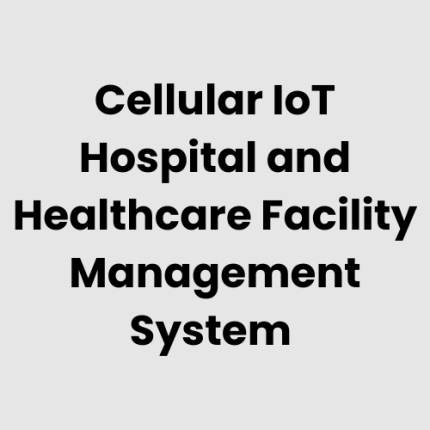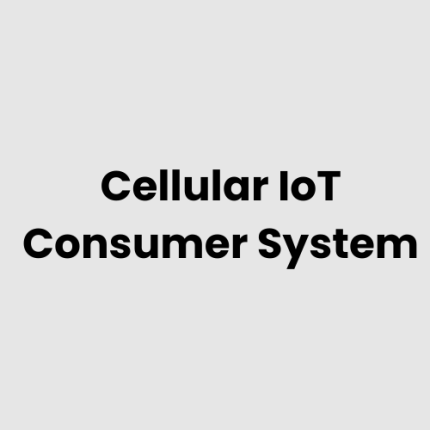Description
Cellular IoT Enabled Fleet Management IoT System
The architecture of the Cellular IoT Enabled Fleet Management IoT System is designed to ensure seamless connectivity and data exchange for fleet management. The system utilizes cellular networks (3G, 4G, and 5G) to provide real-time tracking, vehicle diagnostics, and operational insights. The system includes a central server, vehicle-mounted IoT devices, and cloud-based analytics platforms, allowing fleet managers to monitor vehicle status, optimize routes, and manage maintenance schedules efficiently. The integration of GPS, sensors, and cellular IoT technology ensures high precision and reliability for managing the fleet in any environment.
Hardware of Cellular IoT Enabled Fleet Management IoT System
The hardware components of the Cellular IoT Enabled Fleet Management IoT System include:
- Vehicle IoT Devices: Lightweight cellular IoT devices that integrate GPS, motion sensors, and vehicle diagnostics.
- Cellular IoT Gateway: A gateway device for connecting the fleet management system to cellular networks like 3G, 4G, and 5G.
- Central Server: A local server that collects and processes the data from vehicle IoT devices.
- Cloud Platform: A cloud-based platform for advanced analytics, fleet monitoring, and reporting.
- Sensors: GPS sensors, fuel monitoring sensors, temperature sensors, and motion detectors installed in vehicles.
For more information on IoT systems and cellular IoT devices, visit GAO Tek’s Cellular IoT Devices and Healthcare IoT Devices.
Physical Placement Considerations of the Hardware
The physical placement of the hardware within the Cellular IoT Enabled Fleet Management IoT System should ensure optimal functionality and connectivity:
- Vehicle IoT Devices: These should be mounted securely on the vehicle dashboard or under the vehicle’s body for optimal GPS signal reception and environmental sensor readings.
- Cellular IoT Gateway: Placed in the vehicle’s central console, the gateway should be positioned to maintain continuous cellular connectivity.
- Central Server: Located within a secure data center with high-speed internet connections to manage data storage and processing.
- Sensors: GPS and fuel monitoring sensors should be installed in vehicles where they have direct access to relevant vehicle systems for accurate readings.
For additional insights into IoT hardware placement, visit GAO Tek’s IoT Platform.
Hardware Architecture of Cellular IoT Enabled Fleet Management IoT System
The hardware architecture of the Cellular IoT Enabled Fleet Management IoT System is based on a layered design:
- Edge Layer: The vehicle-mounted IoT devices with sensors that collect real-time data, such as location, speed, fuel usage, and engine diagnostics.
- Communication Layer: The cellular IoT gateway that transmits data from vehicles to the central server over 3G, 4G, or 5G networks.
- Data Processing Layer: A local server or cloud-based platform that receives, stores, and processes data from the fleet in real time.
- Application Layer: The fleet management application that presents the data to fleet managers for analysis and decision-making.
For more details on IoT architecture, refer to GAO Tek’s IoT Systems.
Deployment Considerations of Cellular IoT Enabled Fleet Management IoT System
Deployment of the Cellular IoT Enabled Fleet Management IoT System requires careful consideration of the following:
- Connectivity: Ensure that the cellular networks (3G, 4G, or 5G) provide coverage in the fleet’s operational regions for continuous data transmission.
- Power Supply: The IoT devices should be powered through the vehicle’s electrical system, with battery backups for resilience.
- Integration with Existing Fleet Management Systems: Ensure that the system can integrate with current fleet management software for easy data synchronization and reporting.
- Security: Implement secure data transmission protocols to protect sensitive fleet data from potential threats.
For more on deployment strategies, visit GAO Tek’s Cellular IoT Applications.
List of Relevant Industry Standards and Regulations
- ISO/IEC 27001: Information Security Management
- ISO/IEC 18000: RFID for Industrial Applications
- CE Marking for Electronics
- FCC Regulations for Cellular Communication
- RoHS Compliance for Environmental Safety
- UL Safety Standards for IoT Devices
- GDPR for Data Privacy
- ISO 9001 for Quality Management
Local Server Version of Cellular IoT Enabled Fleet Management IoT System
The Cellular IoT Enabled Fleet Management IoT System can operate with a local server version, where the server is installed within the fleet’s operations center. This setup provides more control over data processing, local storage, and potentially better security by keeping sensitive fleet data on-premises. The local server syncs with the IoT devices and collects data in real-time, ensuring immediate analysis and reporting without relying entirely on cloud-based infrastructure.
For further details on local server setups, visit GAO Tek’s IoT Systems.
Cloud Integration and Data Management
The Cellular IoT Enabled Fleet Management IoT System integrates seamlessly with cloud platforms for scalable data management and advanced analytics. The cloud-based solution allows fleet managers to access fleet data remotely, analyze operational performance, generate reports, and optimize fleet operations. The system employs cloud storage for long-term data retention and provides powerful analytics tools, which can leverage machine learning algorithms for predictive maintenance and route optimization.
For more on cloud solutions and data management, visit GAO Tek’s IoT Systems.
For further details on cloud integration, please explore GAO Tek’s IoT Solutions.
Explore other relevant GAO Tek IoT products and solutions through our IoT Solutions and IoT Applications.
GAO Case Studies of Cellular IoT Enabled Fleet Management IoT System
- Chicago, Illinois
In Chicago, a large logistics company implemented a cellular IoT-enabled fleet management system to optimize delivery routes and improve fuel efficiency. The system tracked vehicle location and condition in real-time, allowing managers to schedule timely maintenance and prevent breakdowns, thus reducing operational costs and improving delivery efficiency. For more information on fleet management technologies, visit FleetOwner. - Los Angeles, California
A prominent transportation firm in Los Angeles utilized a cellular IoT fleet management system to monitor traffic conditions, optimize routes, and track driver behavior. By integrating IoT sensors for vehicle diagnostics and performance data, the company was able to improve fleet efficiency, reduce fuel consumption, and enhance safety standards across its operations. Discover more about IoT solutions on IoTForAll. - New York City, New York
In New York City, a delivery company adopted a cellular IoT fleet management system to enhance operational visibility. The system enabled real-time tracking of deliveries, vehicle health monitoring, and efficient route planning. This reduced delays, streamlined logistics, and improved customer satisfaction through timely deliveries. Learn more about IoT trends on TechRadar. - Houston, Texas
A construction company in Houston implemented a cellular IoT fleet management system to manage a fleet of heavy machinery. The system enabled real-time location tracking, fuel monitoring, and predictive maintenance, significantly reducing downtime and operational disruptions on job sites, while extending the lifespan of the machinery. For more insights into fleet management, check out Fleet Management Weekly. - Miami, Florida
In Miami, a fleet of service vehicles used a cellular IoT fleet management system to monitor tire pressure, engine health, and fuel levels. This proactive approach helped identify potential issues before they caused breakdowns, increasing the reliability of the fleet and reducing the number of unscheduled maintenance events. Explore more on IoT World Today. - Atlanta, Georgia
A logistics company in Atlanta deployed a cellular IoT system to track delivery vehicles across the region. The IoT-enabled system provided real-time updates on vehicle location, performance, and driver behavior, enabling the company to optimize routes, improve fuel efficiency, and ensure compliance with regulatory standards. Stay updated on IoT developments at CNBC. - Dallas, Texas
In Dallas, a national fleet operator leveraged a cellular IoT solution to monitor fleet operations across a large network. The system provided insights into fuel usage, vehicle health, and traffic patterns, which allowed fleet managers to fine-tune operations, reduce waste, and improve overall fleet performance. Read more at Transportation Nation. - Seattle, Washington
A delivery service provider in Seattle implemented a cellular IoT fleet management system to enhance route optimization and driver performance tracking. By integrating vehicle telematics with GPS, the company gained valuable insights that reduced fuel costs and improved delivery efficiency, contributing to an improved bottom line. Discover further details on FleetOwner. - Phoenix, Arizona
A logistics company in Phoenix utilized a cellular IoT-enabled fleet management system to monitor vehicle diagnostics and track real-time location data. This information helped improve vehicle maintenance scheduling and optimize operational workflows, reducing downtime and enhancing fleet performance across the region. Find more information on fleet solutions at IoT World Today. - San Francisco, California
In San Francisco, a delivery and transport service provider employed a cellular IoT fleet management system to enhance vehicle tracking, reduce fuel consumption, and improve safety. The system also allowed fleet managers to monitor driver behavior, providing opportunities for training and improving driving efficiency. Learn more at Supply Chain Dive. - Detroit, Michigan
A large automotive manufacturer in Detroit integrated cellular IoT technology to monitor the condition of its delivery trucks. The system provided real-time diagnostics on tire pressure, engine health, and fuel efficiency, allowing for timely maintenance and reduced operational costs, helping the company improve its logistics efficiency. Visit Fleet Management Weekly for more details. - Denver, Colorado
A transportation company in Denver adopted a cellular IoT-enabled fleet management system to track fleet performance, ensure vehicle health, and optimize routes. The system’s data-driven insights led to improved scheduling, reduced fuel consumption, and higher fleet reliability, resulting in cost savings and increased customer satisfaction. Check out more on IoT For All. - Minneapolis, Minnesota
A regional delivery company in Minneapolis implemented cellular IoT technology to enable real-time tracking of their fleet vehicles. With sensors monitoring vehicle health and fuel levels, the system provided fleet managers with actionable insights that led to improved fuel efficiency and less frequent, costly maintenance. Learn more at CNBC. - Boston, Massachusetts
A transportation firm in Boston deployed a cellular IoT fleet management system to monitor vehicle location, health, and driver performance. The integration of real-time data helped optimize scheduling, reduce operational disruptions, and improve route planning, which led to enhanced service delivery times and customer satisfaction. Find more information on fleet management at Supply Chain Dive. - Washington, D.C.
In Washington, D.C., a governmental agency managed its fleet using a cellular IoT system to ensure real-time vehicle tracking and maintenance monitoring. The system improved operational efficiency and enhanced fleet compliance with government standards, reducing overall fleet costs and ensuring higher levels of performance. For more details, visit FleetOwner.
Case Studies from Canada
- Toronto, Ontario
A distribution company in Toronto leveraged a cellular IoT fleet management system to track vehicles in real time, monitor fuel consumption, and manage maintenance schedules. By integrating IoT sensors with their fleet, they reduced downtime and extended vehicle lifespan, significantly lowering costs while improving service efficiency. For more information on IoT solutions, check out IoT World Today. - Vancouver, British Columbia
In Vancouver, a service provider integrated cellular IoT technology to manage their fleet. The system provided real-time data on vehicle health, location, and driver behavior, allowing for route optimization and improved fuel efficiency. This resulted in enhanced operational efficiency and a reduction in overall fleet costs. Read more at Fleet Management Weekly.
Navigation Menu for Cellular IoT
- Cellular IoT Accessories
- Cellular IoT Devices
- Cellular IoT – Cloud, Server, PC & Mobile Systems
- Cellular IoT Resources
Navigation Menu for IoT
- LORAWAN
- Wi-Fi HaLow
- Z-WAVE
- BLE & RFID
- NB-IOT
- CELLULAR IOT
- GPS IOT
- IOT SENSORS
- EDGE COMPUTING
- IOT SYSTEMS
Our products are in stock and can be shipped anywhere in the continental U.S. or Canada from our local warehouse. For any further information, please fill out this form or email us.
We are looking for partners. For more information on partnering with GAO, please visit Partner with GAO Tek Inc. It lists various ways to partner with GAO, such as OEM Partnerships, Technology Integration, Distribution and Reselling Opportunities, Presenting at the Leading Event Tek Summit, Joint R&D Projects, Training and Consulting Services, Industry-Specific Collaborations, Research and Academic Partnerships.



